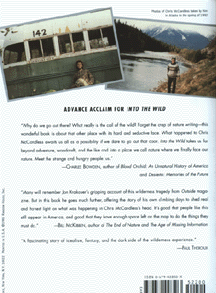

[ Metro | Metroactive Central | Archives]
North to Alaska
Reviewed by Gordon Young
The text on the dust jacket of Jon Krakauer's Into the Wild makes it clear that the thread of suspense running through this compelling book isn't necessarily tied to the fate of its subject. "In April 1992 a young man from a well-to-do family hitchhiked to Alaska and walked alone into the wilderness north of Mt. McKinley," the jacket reads. "His name was Christopher Johnson McCandless. He had given $25,000 in savings to charity, abandoned his car and most of his possessions, burned all the cash in his wallet, and invented a new life for himself. Four months later, his decomposed body was found by a moose hunter."
With the demise of McCandless already revealed, Krakauer concentrates on the forces that drove the devotee of Thoreau, Tolstoy and Jack London to the icy environs of Alaska and, ultimately, to his death. Krakauer's skill as an investigative reporter is impressive, but it is his ability to reveal McCandless' inner motives that makes Into the Wild such an intriguing book.
Instead of coming across as just an antisocial misfit, McCandless emerges as a disciplined, uncompromising individual guided by an earnest brand of asceticism. The same determination that helped him excel as a high school cross-country star enables him to survive the vagabond lifestyle he embraces after college. For McCandless, rejecting mainstream society doesn't mean publishing a zine. He rides the rails, canoes to Mexico on a whim and survives it all on nothing more than wits, luck and an ever-present bag of rice.
In an increasingly crowded world, it was difficult for McCandless to find the physical isolation he sought, but his inward journey was more important than his external surroundings. Krakauer, a writer for Outside magazine who obviously shares McCandless' wanderlust, explains often esoteric inclinations in a clear, revealing way.
"In coming to Alaska, McCandless yearned to wander uncharted country, to find a blank spot on the map," Krakauer writes. "In 1992, however, there were no more blank spots on the map--not in Alaska, not anywhere. But Chris, with his idiosyncratic logic, came up with an elegant solution to this dilemma: He simply got rid of the map. In his own mind, if nowhere else, the terra would thereby remain incognita."
While McCandless viewed nature and solitude as the keys to fulfillment, he profoundly touched those he encountered on the road prior to his fatal journey to Alaska. While prone to introspective musings on the meaning of life, the well-read McCandless could just as easily knock back a few shots of Jack Daniel's and entertain his new-found friends with his piano playing. He comes across as engaging yet ultimately unapproachable in his brash pursuit of raw, austere experience.
Krakauer succeeds in capturing McCandless' unique personality even as he establishes links between his subject and a loose fraternity of adventurers who also took to the wild in search of meaning and identity.
Over the years, Alaska has been a magnet for intrepid characters who trek into the bush, never to reappear. For example, Gene Rosellini, the son of a wealthy Seattle restaurateur, hoped to return to a natural state by scavenging and hunting game with spears and snares. He endured Alaska's bitter winters clad only in rags and fashioned a windowless hut without benefit of saw or ax.
After declaring this experiment a failure, Rosellini made plans to walk around the world, but he never got the chance. He was found lying face down on the floor of his shack in 1991, dead of a self-inflicted knife wound to the heart.
This and other fascinating parallel case studies offer only a glimpse of what prompted McCandless to commune with the harshest side of nature. Arguing that McCandless is more of a "pilgrim" than a "bush-casualty stereotype," Krakauer searches for others who mirror him more accurately.
Everett Ruess, a young adventurer described by Wallace Stegner in Mormon Country as "a callow romantic, an adolescent esthete, an atavistic wanderer of the wastelands," comes closest. In the early '30s, Ruess embarked on a wilderness adventure in Utah and was never seen again. Writing to his brother in 1934, Ruess foreshadowed McCandless' feelings: "I prefer the saddle to the streetcar and star-sprinkled sky to a roof, the obscure and difficult trail, leading into the unknown, to any paved highway, and the deep peace of the wild to the discontent bred by cities."
Krakauer's own foolhardy, yet determined, attempts to climb "an intrusion of diorite mountain called the Devils Thumb" in Alaska during his youth sheds still further light on McCandless. Based on his own experience, Krakauer convincingly argues that McCandless wasn't suicidal, as many have speculated. Instead, he was ruled by the "heedlessness" and "gap-ridden logic of youth" that makes the concept of death as abstract "as non-Euclidean geometry or marriage."
Despite his fate, it is difficult to say that McCandless died in vain. Or to deny that his approach to life is an enviable one in many respects. Although McCandless would probably scoff at the notion, he is a profoundly American figure, uncompromising in his approach and thoroughly optimistic about the future. In an age when the idea of "roughing it" is synonymous with a sport-utility vehicle and an expensive trip to North Face, McCandless was in touch with the bare-bones essence of nature. He is also a reminder of what can happen when you take an all-or-nothing approach to the wild.
[ Metro | Metroactive Central | Archives] ]
This page was designed and created by the Boulevards team.
Why did Chris McCandless turn his back on society and disappear into the wild?

Into the Wild
By Jon Krakauer
Villard; 207 pages; $22 cloth.
From the Feb. 15-21, 1996 issue of Metro
Copyright © 1996 Metro Publishing and Virtual Valley, Inc.